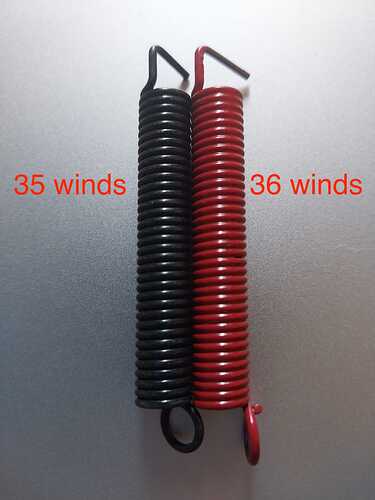Not necessarily. Tremolo springs don’t have a uniform tension. For example, two heavy duty FU Tone springs will be stiffer than most sets of three normal springs.
I was thinking that the spring tension and string tension stay the same. Are three springs at 14 lbs of tension each stiffer than two springs at 21 lbs of tension? You have 42 lbs of tension either way.
Maybe it’s just more balanced, as you say. I would think that two springs at 21 lbs of tension would be harder to stretch to go flat while easier to compress to go sharp. Three springs at 14 lbs each may be more balanced with regard to moving the bridge sharp or flat. Maybe that’s why OP’s bridge tends to go sharp with resting pressure?
Each spring manufacturer will choose k, their spring constant (F = -k x). If I use N springs,
F = - (N k) x,
so It is stiffer as N grows. But of course if one switches manufacturers they could have chosen different k.
Exactly (yes)! The two springs have to be stretched further than the three, but each spring has the same k.
That’s why I ultimately blocked my tremolo. I never purposefully pulled up on the bar enough to make all the times I accidently did so worth it. Not to mention all the issues that come with bending and pitch.
I keep some contact with the bridge on a RG752 (Lo-Pro Edge tremolo, floating, 3 springs) and don’t have an issue, but the thing I can add that may potentially be helpful is that the bridge contact is quite light, really just for some tactile awareness and to make it easy to mute. Most of my anchoring is really done by the forearm on the body’s arm contour itself - I’m not actively applying pressure, but definitely fully resting there.
Curiously, Floyd Rose has a table of forces and displacements for their various stiffnesses of noiseless springs, but only the listed values for their “standard springs” yield a constant value for “k” in Hooke’s law (2000N/m). For their stiffer springs, the listed measurements correspond to a smaller calculated “k” as the displacement (x) increases.
I’m not expert enough to know whether this means their measurements are bad, or if there’s another explanation.
F = -kx is a first-order approximation. It seems pretty plausible that many springs aren’t linear, honestly.
I saw that their high-tension springs for heavy strings have fewer turns, so they get stretched more to get into place, and therefore have a lot more tension to balance the strings. The k has to be selected for a good feel, I’m not sure what their policy is.
Right! But you can measure k right around the deployed length and the value should be pretty accurate. But the main point is, “more springs of a given type results in a stiffer whammy bar.”
^ That. Even if it were close, everything is built to a varying tolerance in the real world which implies there are almost always some non-linearities, which is especially true when dealing with real world materials and their individual properties. With that said, these materials may possess said properties that make this approximation, even if pretty close, finite.
I think everyone has kind of gone off the rails on this one though. I’m not sure how this turn of discussion is particularly helpful even if a specific type here might find it interesting.
WOW JUST @ ME NEXT TIME ( )
)
It wouldn’t be just you. I would have to @ at too many people.
Just to contribute to how far off-topic my own post has gone (or has it?), here’s a photo of FU Tone heavy duty (red) and normal duty (black) springs.
The heavy duty ones are (shitloads) stiffer than the normal ones, to keep it scientific.
Higher k on the red one then!

